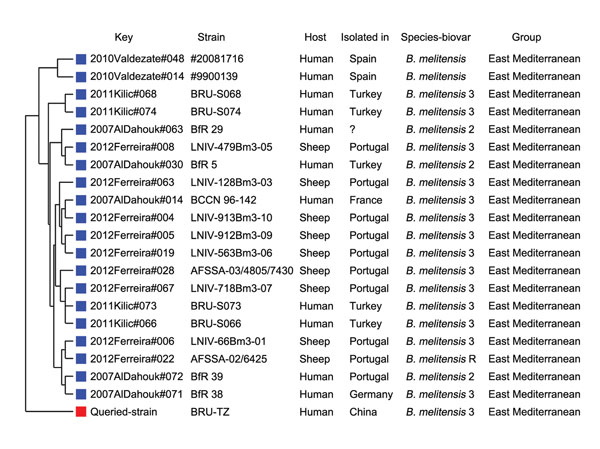Volume 20, Number 1—January 2014
Dispatch
Increasing Threat of Brucellosis to Low-Risk Persons in Urban Settings, China
Figure 2

Figure 2. Genetic relationship between the strain isolated in this study (BRU-TZ) and other Brucella melitensis strains. The variable number of tandem repeats were obtained for phylogenetic analysis at multiple-locus variable-number tandem repeat analysis bank version-4 (http://mlva.u-psud.fr) (5,6). The phylogenetic tree was plotted on the differences in variable number of tandem repeats at 16 loci obtained by multiple-locus variable-number tandem repeat analysis.
References
- Franco MP, Mulder M, Gilman RH, Smits HL. Human brucellosis. Lancet Infect Dis. 2007;7:775–86. DOIPubMedGoogle Scholar
- Gorvel JP. Brucella: a Mr “Hide” converted into Dr Jekyll. Microbes Infect. 2008;10:1010–3. DOIPubMedGoogle Scholar
- Bricker BJ, Halling SM. Differentiation of Brucella abortus bv. 1, 2, and 4, Brucella melitensis, Brucella ovis, and Brucella suis bv. 1 by PCR. J Clin Microbiol. 1994;32:2660–6.PubMedGoogle Scholar
- Corbel MJ. Identification of dye-sensitive strains of Brucella melitensis. J Clin Microbiol. 1991;29:1066–8.PubMedGoogle Scholar
- Al Dahouk S, Flèche PL, Nöckler K, Jacques I, Grayon M, Scholz HC, Evaluation of Brucella MLVA typing for human brucellosis. J Microbiol Methods. 2007;69:137–45. DOIPubMedGoogle Scholar
- Kasymbekov J, Imanseitov J, Ballif M, Schürch N, Paniga S, Pilo P, Molecular epidemiology and antibiotic susceptibility of livestock Brucella melitensis isolates from Naryn Oblast, Kyrgyzstan. PLoS Negl Trop Dis. 2013;7:e2047. DOIPubMedGoogle Scholar
- Economidou J, Kalafatas P, Vatopoulou D, Petropoulou D, Kattamis C. Brucellosis in 2 thalassaemic patients infected by blood transfusions from the same donor. Acta Haematol. 1976;55:244–9. DOIPubMedGoogle Scholar
- Naparstek E, Block CS, Slavin S. Transmission of brucellosis by bone marrow transplantation. Lancet. 1982;319:574–5. DOIPubMedGoogle Scholar
- Singer R, Amitai Y, Geist M, Shimonovitz S, Herzog N, Reiss A, Neonatal brucellosis possibly transmitted during delivery. Lancet. 1991;338:127–8. DOIPubMedGoogle Scholar
- Palanduz A, Palanduz S, Güler K, Güler N. Brucellosis in a mother and her young infant: probable transmission by breast milk. Int J Infect Dis. 2000;4:55–6. DOIPubMedGoogle Scholar
- Meltzer E, Sidi Y, Smolen G, Banai M, Bardenstein S, Schwartz E. Sexually transmitted brucellosis in humans. Clin Infect Dis. 2010;51:e12–5. DOIPubMedGoogle Scholar
- Zhang WY, Guo WD, Sun SH, Jiang JF, Sun HL, Li SL, Human brucellosis, Inner Mongolia, China. Emerg Infect Dis. 2010;16:2001–3. DOIPubMedGoogle Scholar
- Deqiu S, Donglou X, Jiming Y. Epidemiology and control of brucellosis in China. Vet Microbiol. 2002;90:165–82. DOIPubMedGoogle Scholar
- Luk S, To WK. Diagnostic challenges of human brucellosis in Hong Kong: a case series in 2 regional hospitals. Hong Kong Med J. 2010;16:299–303.PubMedGoogle Scholar
- Qiu J, Wang W, Wu J, Zhang H, Wang Y, Qiao J, Characterization of periplasmic protein BP26 epitopes of Brucella melitensis reacting with murine monoclonal and sheep antibodies. PLoS ONE. 2012;7:e34246. DOIPubMedGoogle Scholar
1These authors contributed equally to this article.
Page created: December 18, 2013
Page updated: December 18, 2013
Page reviewed: December 18, 2013
The conclusions, findings, and opinions expressed by authors contributing to this journal do not necessarily reflect the official position of the U.S. Department of Health and Human Services, the Public Health Service, the Centers for Disease Control and Prevention, or the authors' affiliated institutions. Use of trade names is for identification only and does not imply endorsement by any of the groups named above.